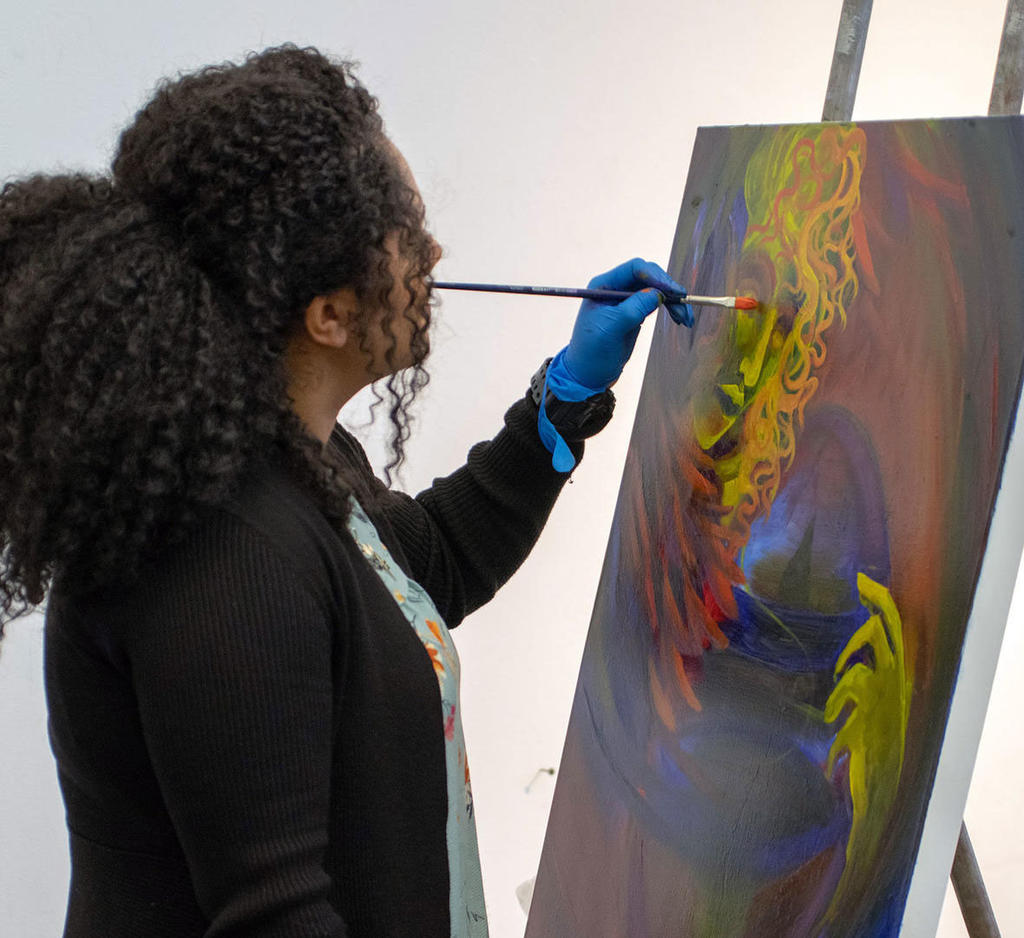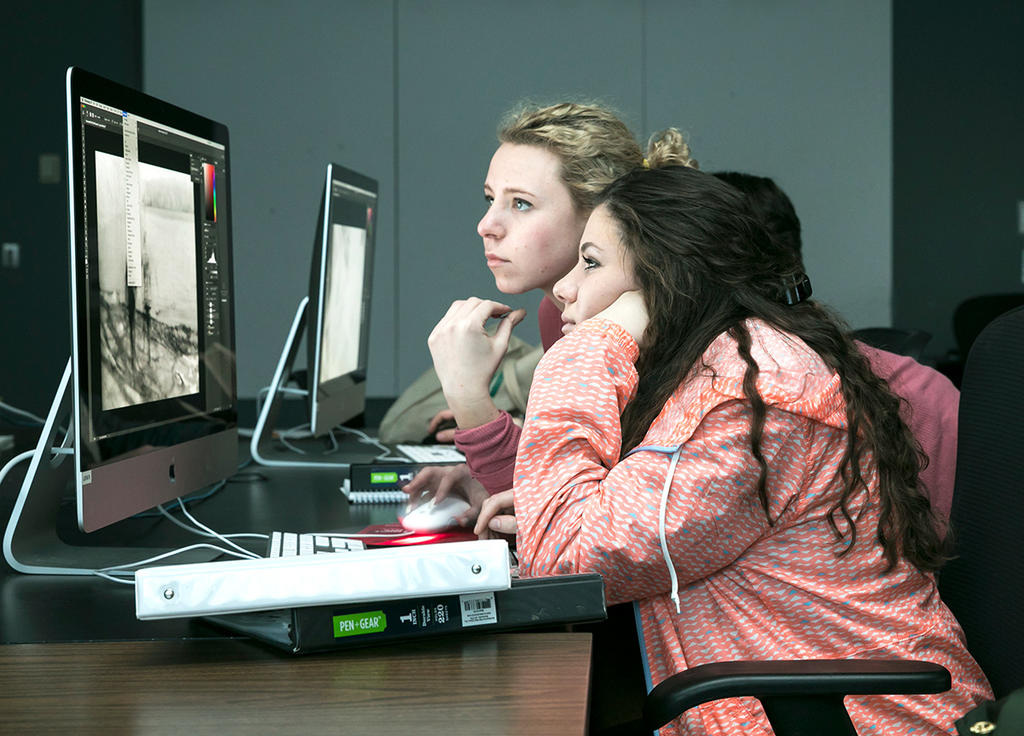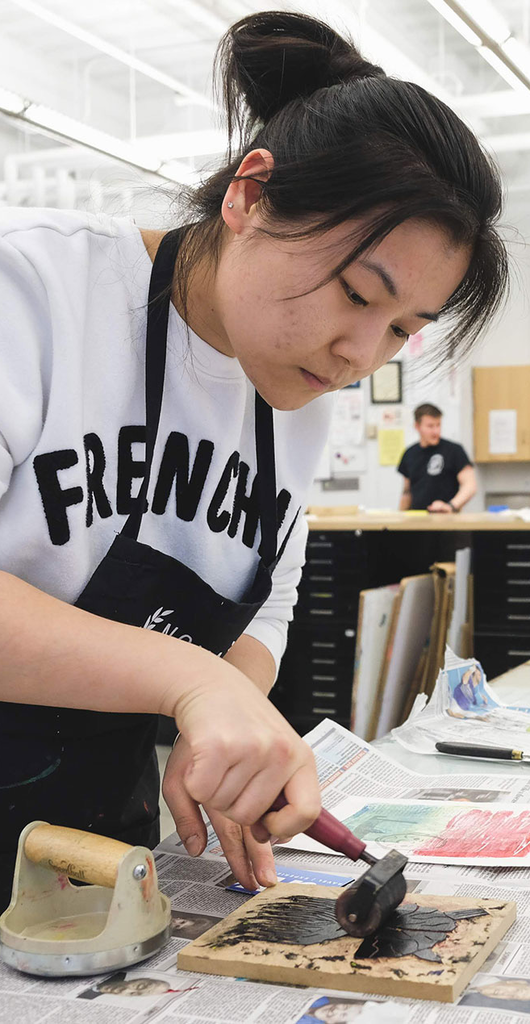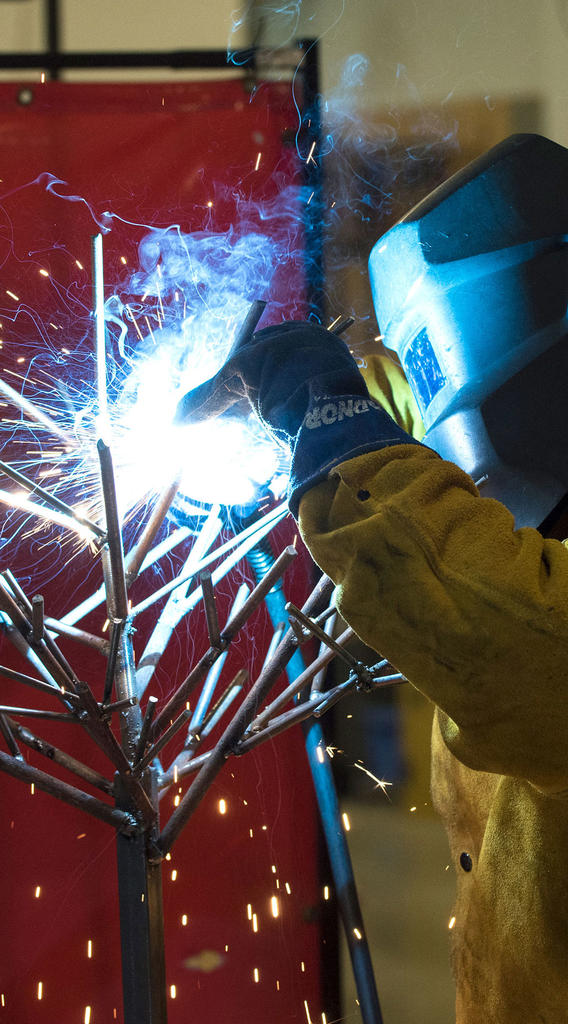Degree programs at the School of Art give students a background in aesthetic and analytical judgment, ethical frameworks for professional practice, the confidence to be both self-reliant and collaborative, and a mastery of design and production. We offer a wide choice of programs including undergraduate and graduate degrees, accelerated master's degrees, certificates, and 10 minors.

Undergraduate
Bachelor of Fine Arts (BFA) in Art and Visual Technology, Concentration in Studio Art
See Four-Year Degree Plan.
This immersive program is thoughtfully designed to provide students with a comprehensive education in the fields of studio art and new media, fostering analytical thinking, creativity, and hands-on experiences. The Bachelor of Fine Arts (BFA) in Art and Visual Technology (AVT) is a 120-credit program that caters to individuals who aspire to become professional visual artists or pursue advanced studies in the arts at the graduate level.
Throughout their college journey, students in the BFA program immerse themselves in an in-depth study of different mediums, allowing for a profound exploration of their artistic interests. In addition to completing the university-wide general education requirements and elective courses, students actively engage in a rich array of learning experiences.
Studio Foundations
The program begins with the Studio Foundations Experience, providing a solid basis in fundamental artistic principles that serve as a springboard for further exploration. From there, students delve into the studio core and research practicum courses, which offer hands-on opportunities to refine their craft, experiment with different artistic techniques, and engage in meaningful creative expression. The study of art history and critical theory complements this practical training, providing students with a contextual understanding of art, its historical roots, and its broader cultural significance.
Concentration in Studio Art
The BFA program encourages interdisciplinary exploration by offering a diverse range of studio electives. Students have the chance to delve into areas such as: Drawing, New Media, Painting, Photography, Printmaking and Book Arts, and Sculpture, enabling them to develop a versatile skill set and embrace experimentation in their artistic practice. This open-minded approach fosters creative growth and allows students to discover their unique artistic voice.
For course descriptions visit the University Catalog.
By blending theoretical knowledge with immersive, hands-on experiences, the BFA program equips students with the necessary tools to navigate the dynamic world of contemporary art. This comprehensive education nurtures artistic growth, cultivates critical thinking skills, and instills a sense of professional readiness. Graduates emerge with the confidence to pursue their artistic ambitions, armed with the ability to adapt to evolving artistic landscapes and make meaningful contributions to the arts community.
Senior Capstone Exhibition
During a BFA student's senior year, they will participate in the Senior Art + Design Show that celebrates the culmination of artistic and design journeys.
Bachelor of Fine Arts (BFA) in Art and Visual Technology, Concentration in Graphic Design
See Four-Year Degree Plan.
This comprehensive program is specifically tailored for students aspiring to pursue a career in Graphic Design, providing them with a well-rounded education that combines theoretical knowledge with real-world experience and professionalism. The Bachelor of Fine Arts (BFA) in Art and Visual Technology, Concentration in Graphic Design is a 120-credit program designed to equip students with the necessary skills and expertise to succeed in the field.
Throughout the program, students engage in a variety of courses that emphasize the practical aspects of Graphic Design. They gain a strong foundation in design principles, visual communication, typography, and digital media. Students also have the opportunity to delve into specialized areas such as branding, illustration, user experience (UX) design, and motion graphics.
The Graphic Design program places a significant emphasis on real-world experiences and industry connections. Students are encouraged to participate in internships, collaborative projects, and professional design competitions. These opportunities allow them to apply their skills in real-world settings, build a professional network, and gain invaluable industry insights. The program also incorporates Professional Practice training, which prepares students for the demands and expectations of the graphic design profession, including client communication, project management, and ethical considerations.
In addition to the practical coursework, students explore the theoretical foundations of design, art history, and critical analysis. They develop a deep understanding of design theory, cultural influences, and the historical context of graphic design, enabling them to create meaningful and impactful visual solutions.
The BFA program with a concentration in Graphic Design strives to nurture students’ creativity, technical proficiency, and professionalism. By combining hands-on experiences, theoretical knowledge, and industry exposure, graduates are well-prepared to enter the competitive world of graphic design and excel in various professional settings, including advertising agencies, design studios, corporate marketing departments, and freelance careers. For course descriptions visit the University Catalog.
Senior Capstone Exhibition
The BFA program culminates with the Senior Art + Design Show that celebrates the culmination of artistic and design journeys. Learn more about the Senior Capstone below.
Bachelor of Arts (BA) in Art and Visual Technology, Concentration in Interdisciplinary Arts
See Four-Year Degree Plan.
This expansive program is designed to offer students a comprehensive liberal arts education while providing a wide range of opportunities for exploration and personal growth. The Bachelor of Arts (BA) in Art and Visual Technology (AVT) is a versatile 120-credit program that encourages students to embrace a breadth of experiences and perspectives within the realm of visual arts.
With a strong emphasis on liberal arts, the BA program goes beyond professional specialization to foster a well-rounded education. In addition to fulfilling the university-wide general education requirements, students have the flexibility to pursue a minor, secondary program, or achieve intermediate proficiency in a foreign language. This allows them to expand their knowledge and understanding in other academic disciplines, broadening their intellectual horizons.
Studio Foundations
The program structure encompasses various components to provide a comprehensive education. The Studio Foundations Experience offers a solid grounding in artistic principles, while the studio core and research practicum courses allow students to further develop their practical skills and engage in hands-on creative work. Art history and critical theory requirements foster a deeper appreciation and contextual understanding of art, encouraging students to analyze and interpret artistic expressions within historical and cultural frameworks.
Concentration in Interdisciplinary Arts
The BA program also offers interdisciplinary studio course electives in areas like Drawing, New Media, Painting, Photography, Printmaking and Book Arts, and Sculpture, providing students with the opportunity to explore diverse areas of art and visual technology. This interdisciplinary approach encourages students to think outside traditional boundaries, fostering creativity, innovation, and collaboration across different artistic domains.
Through this expansive BA program, students are empowered to embrace the full breadth of a liberal arts education, while also cultivating their passion for art and design. By fostering intellectual curiosity, critical thinking, and creative exploration, graduates are equipped with a versatile skill set that prepares them for various career paths or further studies in the arts. Whether pursuing professional opportunities or graduate education, BA AVT graduates are well-prepared to navigate the complexities of the art world and make meaningful contributions to society through their artistic endeavors.
For course descriptions visit the University Catalog.

Graphic Design Certificate for Working Professionals
The Graphic Design Certificate is for working adults with a 4-year baccalaureate undergraduate degree from an accredited institution who seek to gain the skills and competency to advance into a career in graphic design or gain skills to enhance their current work. The certificate must be pursued on a part-time basis, and there may be additional prerequisite courses required. It encompasses a specific body of knowledge and practice that prepares candidates for rewarding positions in the design field. For course descriptions, visit the University Catalog.

Minors
Animation
Open to all majors, the Animation Minor offers a curriculum focused on production, creative storytelling, social issue documentary, and artistic experimentation. Through a range of techniques and processes, including traditional and digital frame animation, stop-motion animation, keyframe animation, and hybrid media practices, students apply their research to create engaging short, animated projects.
The Animation Minor provides a solid foundation in animation principles and methods that can be applied in the creative arts, humanities, and scientific fields. By honing their skills in visual storytelling and artistic expression, students gain valuable insights into the dynamic intersection of art and technology.
Art and Social Change
The Art and Social Change Minor is a dynamic program that explores the intersection of art, activism, and social transformation. Through thought-provoking coursework and collaborative projects, students delve into the profound impact of contemporary art on issues such as social justice, sustainability, and cross-disciplinary research. With a focus on research, critical analysis, and participatory experiments, students gain a nuanced understanding of art's potential as a catalyst for positive change in society.
In this intellectually stimulating environment, students engage in rigorous dialogue and exploration, challenging traditional disciplinary boundaries. The program encourages students to push the boundaries of artistic expression and address pressing issues through immersive experiences and collaborative projects. In addition to finding their creative voice, students will develop the skills and perspectives needed to become agents of positive social change.
The Arts and Social Change Minor offers a range of affiliated courses that complement and enhance students' understanding of art's transformative power. These courses span disciplines such as arts management, anthropology, communication, documentary filmmaking, and social justice, providing students with a broader context for their artistic practice and deepening their engagement with social issues.
Design Thinking
Design Thinking is a process that uses interdisciplinary approaches to designing, building, and evaluating user experiences across a range of technologies, systems, and objects. People with design thinking skills are in high demand across a range of industries including software and website development, product design, user experience design, instructional design, architecture and planning, global health, global management and consulting, and international development. These skills prepare graduates to be flexible and adaptable in different roles and careers.
Students will choose from one of two tracks: Design in the Built Environment or User Experience Design.
All students have opportunities to conduct independent research, engage in globally-related activities, participate in public service, and prepare for their future careers through internships, career-focused minors, and other college-to-career activities.
Digital Media and Web Design (interdisciplinary)
The Digital Media and Web Design Minor is an interdisciplinary program (in conjunction with College of Humanities and Social Sciences) designed to equip students with the skills and knowledge needed to thrive in the rapidly evolving field of digital media, web design, and user experience. By combining courses in web design, graphic design, content development, and user experience, students gain hands-on experience and a comprehensive understanding of how to create, manage, and optimize digital media and web interfaces.
To declare this minor: Visit the School of Art Office (Art and Design Building, Suite 2050) to pick up the Minor Declaration Form or email the School of Art office. No appointment is necessary.
Dynamic Publishing
The Dynamic Publishing Minor gives students from any major a choice of two interrelated tracks: one in Art and Design, focused on publishing modes ranging from book arts to comics to digital design, and the other in Editorial and Production, focused on core acquisitions, editing, and production processes across a variety of publishing environments. The co-curricular makeup of the minor prepares students for the highly interdisciplinary world of publishing, which requires that its workforce has the ability to collaborate across a wide range of academic disciplines and professional fields. The Dynamic Publishing minor is ideal for students seeking an academic credential for professional or graduate-school work in many different aspects of publishing, and also for artists and writers who want to learn more about the process of publishing from new perspectives.
Graphic Design
This minor distills many of the important skills from our BFA Graphic Design program to allow for an understanding of how to deliver information in visual formats, with coursework in typography, web design, and graphic design history. The program also incorporates Professional Practice training, which prepares students for the demands and expectations of the graphic design profession, including client communication, project management, and ethical considerations.
All graphic design minor students are required to take AVT 110 Digital Design Studio as a prerequisite to the Graphic Design Minor. For course descriptions, visit the University Catalog.
Illustration
This minor helps students to understand both the artistic and professional demands of Illustration, working to provide the skills to make concepts understandable and powerful in the service of editorial, informational or persuasive goals. Students will begin to discover individually unique methods of problem solving by developing a personal visual vocabulary and relating it to historical and contemporary trends of art, design and illustration
Prospective Illustration minor students should AVT 222 Drawing I (Mason Core) prior to applying.
Photography
The Photography Minor offers students a focused and comprehensive exploration of the art and craft of photography. Through this program, students engage in a dynamic learning experience that encompasses various aspects of the field. They gain proficiency in digital photography, learning to master the technical aspects of capturing and editing images using advanced digital tools. Additionally, students have the opportunity to immerse themselves in the rich tradition of darkroom photography, acquiring skills in film development, printing, and traditional darkroom techniques. The minor also includes instruction in professional lighting, enabling students to understand and utilize light effectively in their photographic compositions.
By combining theoretical knowledge with hands-on practice in digital photography, darkroom techniques, and lighting, students develop a well-rounded skill set that prepares them to excel in their creative endeavors and apply their photographic expertise in their chosen career paths. For course descriptions, visit the University Catalog.
Photojournalism
The Photojournalism minor explores photography as a journalistic storytelling medium. Offered jointly by the Department of Communication and the School of Art, the minor prepares students to bear witness through the lens of a camera; to examine the world around them, pose questions and inform audiences. Students gain proficiency with digital photo technology, develop reporting skills, apply visual storytelling principles, and examine the ethical and legal challenges of capturing stories in a mediated society. For course descriptions, visit the University Catalog.
Studio Art
The Studio Art minor requires 18 credits and offers a core of foundational studies with the opportunity for further study in the following areas: Drawing, Graphic Design, New Media Art, Painting, Photography, Printmaking and Book Arts, and Sculpture. For course descriptions, visit the University Catalog.
Web Design
The Web Design minor at the School of Art offers students the opportunity to delve into the dynamic world of web design. In an increasingly digital age, web design plays a crucial role in shaping our online experiences. This minor equips students with the skills to craft visually appealing, user-friendly websites that engage audiences and meet the demands of the modern digital landscape.
Web design encompasses visual design, user experience (UX) principles, information architecture, and interactive elements. Through this minor, students gain proficiency in industry-standard tools, learn graphic design principles, and develop an understanding of creating aesthetically pleasing and intuitive websites.
Courses in the Web Design Minor include Introduction to Web Design, Graphic Design Methods and Principles, Mobile App Design or Motion Design, Advanced Web Design, and Web Design and Usability. Students learn HTML, CSS, layout, typography, and more to design websites that are visually impactful and user-centered.
The Web Design Minor prepares students to become proficient web designers who can effectively communicate ideas, create visually compelling experiences, and shape the digital landscape. By combining technical skills with creative thinking and user-centric approaches, students are prepared to design websites that captivate users and deliver meaningful content. For course information, please visit the University Catalog.

Accelerated Master's
The College of Visual and Performing Arts offers several options for our undergraduate students to start working on their Master's degree while completing their Bachelor's degree. One of the best reasons to choose an accelerated degree is the cost as you’ll pay undergraduate tuition rates for graduate coursework taken in your junior and senior years, saving you thousands of dollars in comparison to a traditional degree program. You can earn both your bachelor's and master's degrees within five years, saving you time, and you’ll pay no application fees for your graduate program. See more reasons why an accelerated program might be right for you.
See the video below under Graduate programs to hear Dr. Justin Sutters, director of the Master of Arts in Education program talk about the accelerated MAT option.
Art and Visual Technology, BFA/Art Education, Accelerated Master of Arts in Teaching (MAT)
The Art and Visual Technology, BFA/Art Education, Accelerated Master of Arts in Teaching program allows academically strong undergraduate students to earn a BFA in Art and Visual Technology, a graduate degree in Art Education, while simultaneously satisfying the requirements for PreK-12 Art licensure in the Commonwealth of Virginia. Candidates will learn how to teach visual arts by engaging in diverse studio work, curriculum design, research projects, class observations at Fairfax County Public Schools (FCPS), elementary and secondary methods courses, and a capstone pre-service internship and seminar.
Requirements for attaining licensure in PreK-12 Art include a combination of completing 30 credits total (18 graduate credits can be taken during undergraduate program at undergraduate tuition rate) which includes a culminating semester of student teaching full-time. To attain state licensure, students are advised to satisfy the 36 credits of art endorsements required by the state and usually meet those requirements through their BFA program of study. Licensure candidates also must receive a passing score on the National (Praxis) and state (VCLA) exams before student teaching.
Contacts:
- Program Director- Justin Sutters
- Program Advisor- Robert Yi
Art and Visual Technology, BA or BFA/Arts Management
Academically strong undergraduates in Art may apply to the accelerated Master’s Degree in Arts Management. If accepted, students will be able to earn an Art and Visual Technology, BA or Art and Visual Technology, BFA, as well as an Arts Management, MA after satisfactory completion of 150 credits. This accelerated option is offered through joint cooperation between the School of Art and the Arts Management Program.
For more detailed information, see AP.6.7 Bachelor's/Accelerated Master's Degrees. For policies governing all graduate degrees, see AP.6 Graduate Policies.
Contact: Arts Management, M.A. Accelerated Masters: Karalee Dawn MacKay

Graduate student Steven Luu preparing for his 2023 MFA Exhibition Reinventing My Narrative, at Gillespie Gallery of Art
Graduate
Master of Arts in Teaching (MAT)
The Master of Arts in Teaching (MAT) program is a pre-service graduate degree for students that already have an undergraduate degree in a related field. At the culmination of completing coursework and a semester of student teaching, students satisfy Commonwealth of Virginia requirements to attain licensure in PreK-12 Art. The 30-credit degree program includes studio components, site observations at surrounding public schools, contemporary theory and curriculum design. In the past four years, 100% of our job-seeking graduates have attained a contracted position in regional public schools within a year of graduation. For course descriptions, please visit the University Catalog.
This program has been identified by George Mason University as one that may lead to a career requiring professional licensure/certification. Federal regulations require Mason to disclose information as to whether this program meets/does not meet the educational requirements for licensure/certification in your state, or whether such a determination has not been made. Please consult our Licensure Disclosure Tool for the disclosure statement specific to your desired state/program combination.
Contacts:
- Program Director- Justin Sutters
- Program Advisor- Robert Yi
Art Education Licensure Graduate Certificate
The Art Education Licensure Certificate (AELC) is a post-baccalaureate program designed for those who currently hold a graduate degree in an art-related field along with those who want a more immediate entrance into the art teaching profession. This "licensure only" program, which results in a pre K-12 art certification in the Commonwealth of Virginia, is a 21-credit program consisting of graduate education courses, student teaching internships and seminar. (The MAT I is the option for Master’s plus licensure, which requires an additional six credits and is for those who do not already have a graduate degree).
Program Advisor: Robert Yi
Master of Fine Arts (MFA) in Visual and Performing Arts, Concentration in Visual Arts
The Master of Fine Arts (MFA) is a terminal degree that prepares students to become professional artists, work in technology or arts-related fields, and teach at the university level. The College of Visual and Performing Arts offers an MFA in Visual Arts and Graphic Design.
Candidates are required to complete 60 credits, culminating in a Thesis Exhibition of the student’s work in George Mason’s Gillespie Gallery of Art. Of those credits, 45 credits are made up from both core and studio requirements, and an additional 15 credits are based on comprehensive experience. MFA Visual Arts students may choose an emphasis in new media art, painting and drawing, photography, printmaking, or sculpture. For course information, please visit the University Catalog.
The MFA Program seeks to develop in students a self-directed studio practice, derived simultaneously from an earnest personal search and an engagement with contemporary discourses and practices.
Housed in a small communities of studios, the MFA program offers an environment that fosters the deepening of a student’s individual practice in the context of shared experience and dialogue with peers. Daily studio practice is supplemented by courses in research, writing, and contemporary critical theory. Regular formal critiques with peers and faculty track student progress, while training them to articulate ideas relevant to the production of their work. Visiting artists, monthly trips to New York galleries, and suggested supplementary lectures at local venues contribute to the student’s ability to contextualize his or her own work and process within the larger conversation of contemporary studio practices. MFA students have numerous opportunities to collaborate and exhibit their work in local galleries; including but not limited to the Workhouse Arts Center.
Program Advisor: Robert Yi
Master of Fine Arts (MFA) in Visual and Performing Arts, Concentration in Graphic Design
The Master of Fine Arts (MFA) is a terminal degree that prepares students to become professional artists, work in technology or arts-related fields, and teach at the university level. The College of Visual and Performing Arts offers an MFA in Visual Arts and Graphic Design.
Candidates are required to complete 60 credits, culminating in a Thesis Exhibition of the student’s work in George Mason’s Gillespie Gallery of Art. Of those credits, 45 credits are made up from both core and studio requirements, and an additional 15 credits are based on comprehensive experience. MFA Visual Arts students may choose an emphasis in new media art, painting and drawing, photography, printmaking, or sculpture. For course information, please visit the University Catalog.
The MFA Program seeks to develop in students a self-directed studio practice, derived simultaneously from an earnest personal search and an engagement with contemporary discourses and practices.
Housed in a small communities of studios, the MFA program offers an environment that fosters the deepening of a student’s individual practice in the context of shared experience and dialogue with peers. Daily studio practice is supplemented by courses in research, writing, and contemporary critical theory. Regular formal critiques with peers and faculty track student progress, while training them to articulate ideas relevant to the production of their work. Visiting artists, monthly trips to New York galleries, and suggested supplementary lectures at local venues contribute to the student’s ability to contextualize his or her own work and process within the larger conversation of contemporary studio practices. MFA students have numerous opportunities to collaborate and exhibit their work in local galleries; including but not limited to the Workhouse Arts Center.
Program Advisor: Robert Yi
What Are My Options in Art Education?
Dr. Justin Sutters, Director of the Master of Arts in Teaching (MAT), explains the options open to students wishing to pursue a degree and licensure in Art Education, as well as the BAM or Bachelor's to Master's accelerated option.
